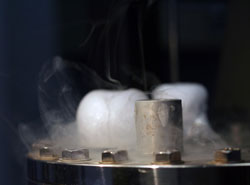Plant preservation progresses
Human activities are eliminating biological diversity at an unprecedented rate. Furthermore, it only takes the removal of one species in a bionetwork to create the subsequent loss of many. To help stem this loss, various organisations worldwide have set up gene and germplasm banks. Cryo-preservation however poses various problems in terms of tissue damage through the formation of ice crystals and damage to the delicate cell structure. Researchers of the European project CRYMCEPT have therefore devised new methods to successfully preserve plant species. The protocols developed took into account the cell type and region of extraction from the plant as each has its own unique structure and consequent requirements. Techniques were developed for actively dividing cells at the tips of shoots, several woody species and seeds, among others. As a main source of genetic variation, the seed is a valuable plant organ. Five key stages in the process of coffee seed preservation were investigated including the effects of seed quality and optimal hydration status. After the results were obtained, the cryo-preservation methods were modified accordingly. Maintaining the integrity of plant material after the storage period was also an important objective. Problems such as desiccation and post-thaw shoot regeneration were addressed. The success of the research overall is self-evident. Preservation of banana material has become a routine procedure and over 400 banana samples were put into storage in liquid nitrogen at project partners' research headquarters in Leuven in Belgium. Going beyond the original project objectives, the techniques can be used for other plant species like strawberry, apple and almond, date palm and potato. Advancements in cryo-preservation techniques will be an advantage to any organisation involved in the preservation of germplasm or the use of genetic resources of species. Botanic gardens, seed banks, biotechnology companies and culture collectors all stand to benefit. For more information on the project, go to http://www.agr.kuleuven.ac.be/dtp/tro/crymcept for background, links and details.







